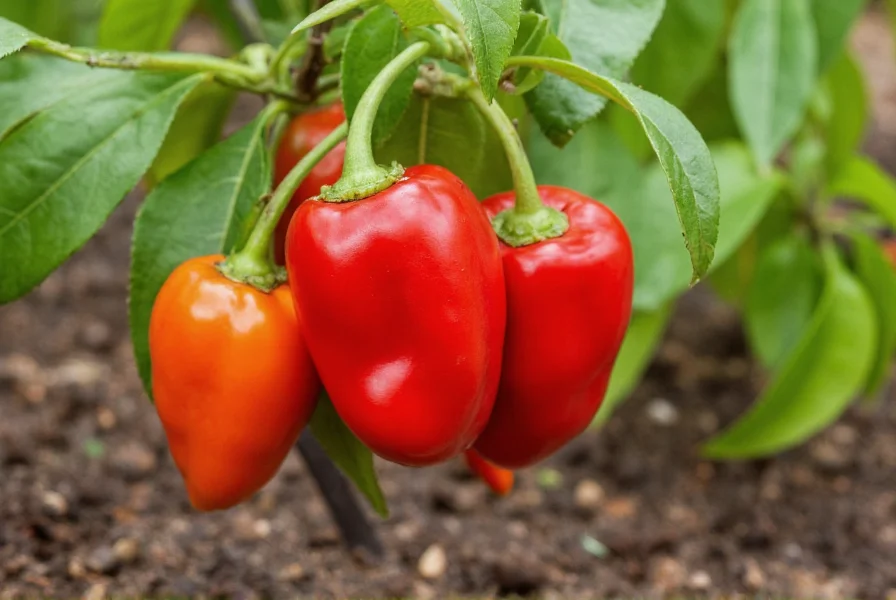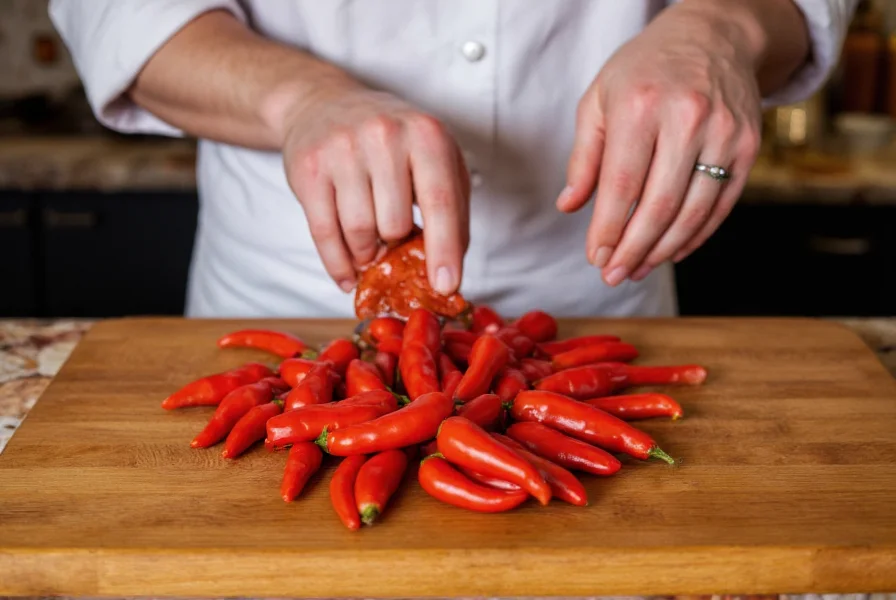When gardeners and chefs mention brick chili, they're usually describing peppers that have reached full maturity with a rich brick-red hue. This color transformation signals optimal sugar development and complex flavor compounds, distinguishing them from their greener, less mature counterparts. Understanding these specific chili characteristics helps both home growers and culinary enthusiasts maximize their use.
Identifying True Brick Chili Characteristics
The term "brick chili" isn't a formally recognized cultivar but rather describes the mature stage of certain chili varieties. These peppers typically measure 4-7 inches long with a tapered shape and smooth, glossy skin that transitions from green to vibrant brick-red as they ripen. The distinctive color comes from increased carotenoid development during the final maturation phase.
Unlike the common misconception that all red chilies are extremely hot, authentic brick-colored varieties maintain a manageable heat level. The brick red chili pepper characteristics include moderate capsaicin concentration that provides warmth without overwhelming heat, making them suitable for various palates. Their flavor profile balances fruity sweetness with earthy undertones and subtle smokiness.

Heat Level and Flavor Profile Analysis
When evaluating how hot is brick chili on the Scoville scale, most mature brick-red varieties register between 30,000-50,000 units. This places them in the medium-heat category—significantly milder than habaneros (100,000-350,000 SHU) but noticeably hotter than jalapeños (2,500-8,000 SHU). The heat distribution follows standard chili patterns, with the highest concentration in the placental tissue surrounding the seeds.
Culinary professionals appreciate brick chilies for their complex flavor development. As the peppers mature to their characteristic brick-red color, their sugar content increases by approximately 30% compared to green stages, creating a more rounded taste profile. This maturation process develops flavor compounds that include:
- Earthy, almost tobacco-like notes
- Subtle fruitiness reminiscent of dried apricot
- Warm, lingering heat rather than sharp burn
- Delicate smokiness even before drying
Optimal Growing Conditions for Brick-Red Chilies
Successfully cultivating peppers that develop the prized brick-red color requires specific growing conditions. Gardeners seeking to grow authentic brick red chili peppers should note these critical factors:
| Growing Factor | Optimal Condition | Impact on Brick Color Development |
|---|---|---|
| Temperature | 75-85°F (24-29°C) daytime | Temperatures below 70°F slow pigment development |
| Sunlight | 6-8 hours direct sun daily | Insufficient light produces paler, less vibrant color |
| Watering | Consistent moisture, slight drying between waterings | Overwatering delays ripening and color change |
| Soil pH | 6.0-6.8 | Extreme pH affects nutrient uptake and color intensity |
For best results when growing brick red chili peppers, allow peppers to fully mature on the plant until they develop uniform brick-red coloration. Premature harvesting prevents full flavor development. The transition from green to brick-red typically takes 2-3 weeks after initial color change, requiring patience for optimal results.
Culinary Applications and Substitution Guidance
The versatile flavor profile of brick chilies makes them valuable across multiple culinary applications. When considering culinary uses for brick red chilies, professional chefs recommend these techniques:
Roasting and pureeing brings out their natural sweetness while mellowing the heat—ideal for enchilada sauces and salsas. The brick-red color also provides vibrant visual appeal to dishes without artificial coloring. For dried applications, brick chilies produce excellent chile powder with more complex flavor than standard red pepper flakes.
Understanding proper substitutions is crucial when brick chili vs cayenne availability becomes an issue. While cayenne peppers often reach a similar red color, they typically run hotter (30,000-50,000 vs 50,000-100,000 SHU for cayenne). Better substitutes include:
- Guajillo peppers (milder, similar earthy notes)
- Mature New Mexico chilies (nearly identical profile)
- Dried pasilla peppers (use 1:1 ratio when rehydrated)

Harvesting and Preservation Techniques
Proper harvesting ensures maximum flavor development in brick chilies. Wait until peppers develop uniform brick-red coloration with slight softening when gently squeezed. Use sharp scissors to cut stems, leaving 1-2 inches of stem attached to prevent damage.
For long-term storage, several preservation methods maintain the distinctive qualities of brick chilies:
- Drying: String peppers on twine and hang in warm, dry area with good airflow. Properly dried brick chilies retain 90% of flavor compounds.
- Freezing: Roast first for best texture retention. Frozen brick chilies maintain quality for 12 months.
- Vinegar preservation: Create flavorful pickled chilies by submerging in 5% acidity vinegar solution.
When exploring where to find these specialty peppers, check local farmers markets during late summer through fall when brick-red varieties reach peak maturity. For gardeners interested in where to buy brick chili seeds, specialty seed companies often carry New Mexico No. 6 or similar varieties that develop the characteristic brick-red color.
Frequently Asked Questions
Are brick chilies the same as cayenne peppers?
Brick chilies aren't a specific variety but describe mature peppers with brick-red coloration. While some cayenne varieties reach this color, true brick-red chilies typically have lower heat (30,000-50,000 SHU) compared to standard cayenne (50,000-100,000 SHU). The flavor profile also differs, with brick chilies offering more earthy notes and less sharp heat.
How long does it take for chilies to develop brick-red color?
After initial color change from green, most chili varieties require 2-3 weeks to develop full brick-red coloration. This maturation period allows sugar development and complex flavor compounds to form. Temperature significantly affects timing—warmer conditions accelerate color development while cooler temperatures prolong the process.
Can I use green chilies instead of brick-red mature ones?
Green chilies provide a different flavor profile—more vegetal and less sweet with sharper heat. While substitution is possible, expect significant taste differences. For closest approximation, use 1.5x the amount of green chilies plus 1/4 teaspoon sugar per pepper to mimic the mature brick-red variety's sweetness and complexity.
What soil conditions produce the best brick-red color in chilies?
Chilies develop optimal brick-red color in slightly acidic soil (pH 6.0-6.8) with balanced nutrients. Excessive nitrogen produces dark green foliage but delays ripening and color development. Adding calcium and magnesium supplements during flowering stage enhances pigment development. Consistent moisture without waterlogging is crucial—allow top inch of soil to dry between waterings.











 浙公网安备
33010002000092号
浙公网安备
33010002000092号 浙B2-20120091-4
浙B2-20120091-4